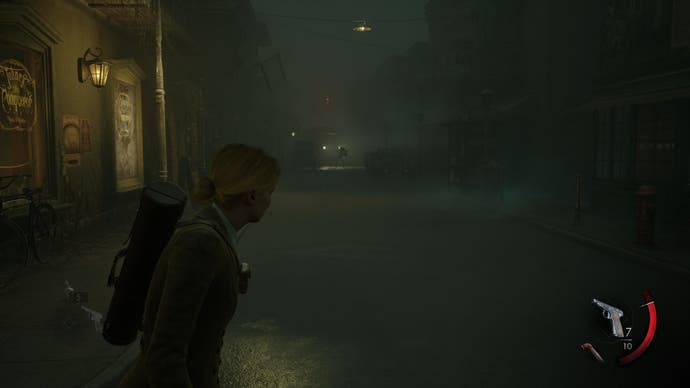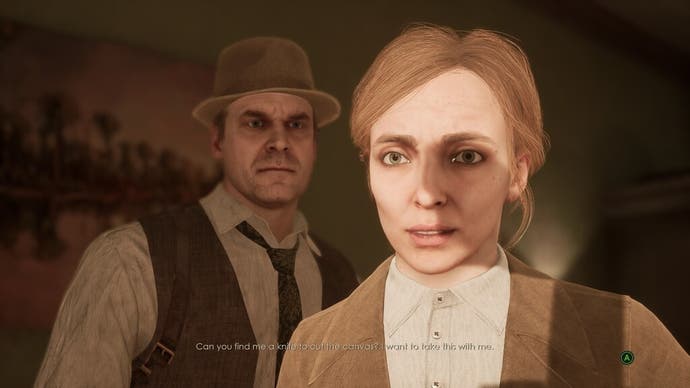Survival horror fans have been treated in recent years with the revival of classic games in the genre. Resident Evil has led the charge, with the likes of Dead Space and Silent Hill following. Now, developer Pieces Interactive and publisher THQ Nordic hope their Alone in the Dark reimagining can follow suit, and deliver a fresh-feeling experience for a modern audience while sticking closer to the survival horror genre's roots than perhaps we've seen recently.
This point was one producers Andreas Schmiedecker and Michael Paeck were keen to emphasise during an early look at the game a couple of weeks ago. As I was shown snippets of the game through a hands-off demo, two key tenets of survival horror were highlighted: non-linear exploration and puzzle solving, and linear combat sections.
Most of Alone in the Dark's puzzle solving happens within Derceto Manor, a care home which protagonists Emily Hartwood (played by Jodie Comer) and hired private investigator Edward Carnby (David Harbour) travel to in order to find Emily's uncle Jeremy. Many of the rooms in the manor are inaccessible at the beginning of the game but are eventually unlocked as you progress. Manor exploration is recorded on the map in the standard ways - rooms will turn from red to blue if everything of interest has been completed, blocked off doors will be marked with symbols to let you know what's needed.
It's easy to forget which key is needed where, especially if you're directionally challenged (very bad at using maps) like me, and I was impressed with the new player guidance options that help show you what's important in your environment, as well as any clues to be explored next. There's an old-school option which has none of these puzzle aids turned on, and a modern preset which has all of them turned on. The latter adds information needed to solve puzzles, map markers to notify you when a room can be opened up, more descriptive objectives in the journal, and makes interaction prompts appear in the world from further away.
You can toggle any of these on whenever you want for your own custom settings, and Schmiedecker told me this was important in helping to make the game accessible for different types of players. "Some players are better with navigation of a 3D space, it's a different skill to reading," he said, "and we don't want to lump them together." The game stops short of giving you exact solutions, preventing it from turning into hours of fetch quests and "go here and enter this code". Instead, you're given more context and direction in solving puzzles. Paeck says this was important to the team, as the developer wanted to maintain the legacy of the original game. "We wanted to have more of this real detective work in there," he told me, "and that also makes it stand out from all the other horror games of recent times."

The trend of recent horror games being more action-oriented is something which Alone in the Dark can't escape from - in particular, during its nightmarish, dream world sequences. Emily and Edward are thrown into various otherworldly dimensions as they follow Jeremy's trail, in areas filled with enemies to either sneak past or confront. As ever, ammo and health items are limited. The environment contains throwable items scattered around, which can be used to distract enemies or thrown at them to stagger them and do a bit of damage. Melee weapons can be picked up and used but will break after a few hits. When demoed by Schmiedecker, combat looked fairly standard - and indeed it feels very standard once I got my hands on the game.


I had a couple of hitches with the enemy AI, which would often stay standing at the place where they last had track of me and refused to leave, essentially removing my option to run away if I was trapped down a narrow alley. After playing for a few hours, I have a very specific grievance with animations. Whilst getting onto a ladder you cannot be hurt or interrupted, but whilst trying to heal you can. A small thing, perhaps, but it highlighted a detail where the game lost some of its immersion.
You lose control of characters as they slowly open doors, giving the camera the opportunity to zoom close in over the shoulder and peer into the room as gradually more is revealed. These moments are great for tension, as you start to worry there could be something bad behind the door, but it comes off as scripted. It also becomes a time-waster specifically in Derceto Manor once you learn the tells of the environment shifting between the real world and when Jeremy's nightmares start to seep through.

Sometimes I found the game's facial animations a little stiff, which is a shame as Comer and Harbour put in great performances as Emily and Edward - from what I've seen so far. These small things kept reminding me of that return to classic survival horror, but in the ways that survival horror games in the 90s were bound by technical limits.
Is a "true" survival horror game really so divided between puzzling and combat? The separation of these two elements in the first couple of chapters of Alone in the Dark is very apparent, and I'm not sure if that's a good thing. The tense combat encounters within Jeremy's nightmare worlds make the sections of exploring Derceto Manor feel like a respite, but I also get the sense this is a game of two halves. One half is driven by story (and I think worldbuilding and characters are presented in a way that introduces them organically rather than a lore dump or lengthy section of exposition). The other half is driven by urgency and a simple need to get from point A to point B.
Still, Alone in the Dark's story is pulling me on to play more. Emily's background with Derceto and the people who live there is explored within those first couple of hours if you play as her, while Edward's relation to Derceto is only hinted at in the first two chapters of his campaign, leaving his personal stakes in the plot unrevealed. I'm also excited to see how this stacks up to the likes of the recent Resident Evil remakes, as both a survival horror and Resident Evil fan. The comparisons between the two are inevitable, as the original 1992 Alone in the Dark went on to inspire Capcom's legendary series. Now, Pieces Interactive has taken inspiration from Resident Evil. "We were inspired by the stuff Resident Evil did, like the [over-the shoulder] camera," Paeck told me, "so it's basically a circle-to-circle inspiration kind of thing".
I've enjoyed what I've played so far. In the notes I made while playing I described the soundtrack as "timely moroseness", which is exactly the sort of feeling I would want doom jazz to evoke. I'm intrigued to find out what Emily and Edward's backstories are, and whether we can rescue Jeremy from the mysterious Dark Man. There's still a few months to go before we can play through the whole game, however, as last week THQ Nordic announced a delay to Alone in the Dark, which will now release on 20th March, 2024, on PC, PlayStation 5 and Xbox Series X/S.
Article From & Read More ( Alone in the Dark doubles down on its survival horror legacy, for better and worse - Eurogamer.net )https://ift.tt/bNyq1oM
Technology
No comments:
Post a Comment